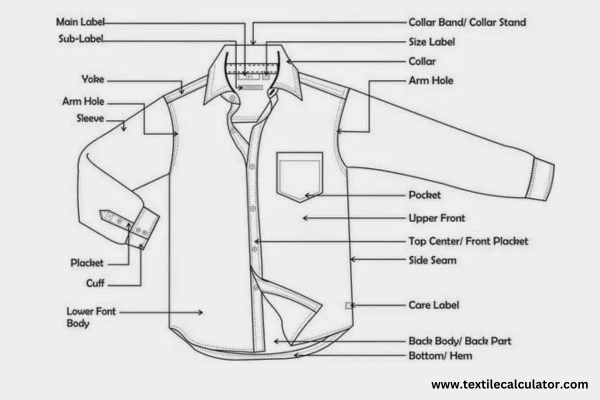Fabric consumption is a crucial factor in the production of shirts, influencing both cost and sustainability. By comprehending the intricacies of fabric consumption, manufacturers can optimize resources and create garments that meet quality standards. This article delves into the key aspects of fabric consumption for shirts, shedding light on the various components involved.
Table of Contents
Fabric Consumption for Shirt
Consumption for Body Section
For Body = [{(Body length + allowance)×(½ chest + allowance)}×2×GSM×12]/10000000
Fabric Consumption for Body Section of Shirt (Kg/Dz)
Result:
Consumption for Sleeve Area
For sleeve= [{(Sleeve length + allowance)×(½ Armhole + allowance)}×GSM×12]/10000000
Fabric Consumption Calculator – Sleeve Section of Shirt (Kg/Dz)
Result:
Consumption for Half Moon Area
For half-moon = [{(Length of half-moon + allowance)×(Width of half-moon + allowance)}×2×GSM×12]/10000000
Fabric Consumption Calculator – Half-Moon Section of Shirt (Kg/Dz)
Result:
Consumption for Pocket Area
For pocket = [{(Length of pocket + allowance)×(Width of pocket + allowance)}×GSM×12]/10000000
Fabric Consumption Calculator – Pocket Section of Shirt (Kg/Dz)
Result:
Total Fabric Consumption for Shirt Calculator
Total Fabric Consumption Calculator for a Shirt (Kg/Dz)
Total Fabric Consumption Result:
Example
Follow the measurement from here:
| Actual length | Allowance | Measurement with Allowance | |
| Body length | 70cm | 6cm | 76cm |
| Sleeve length | 22cm | 6cm | 28cm |
| ½ Chest width | 56cm | 6cm | 62cm |
| Collar length | 40cm | 0cm | 40cm |
| Collar width | 8cm | 8cm | 11cm |
| Cuff length | 22cm | 4cm | 26cm |
| Cuff width | 3cm | 2cm | 5cm |
| Pocket length | 10cm | 3cm | 13cm |
| Pocket width | 9cm | 3cm | 12cm |
| Half-moon length | 16cm | 3cm | 19cm |
| Half-moon width | 8cm | 3cm | 11cm |
Now, find out the fabric consumption for the above order.

So, in the below, now I will present the total fabric consumption method for the above order in part by part:
1. Fabric consumption of Body parts (Body + Sleeve)
= {(Body length + Sleeve length)×(½ chest width)×2×GSM×12}/10000000
= {(76+28)×62×2×160×12}/10000000 (In kg)
= 2.48 kg/dz
2. Fabric’s consumption for Collar:
= (Collar length×Collar width×12×GSM)/10000000
= (40×11×12×230)/10000000
= 0.12144kg/dz
3. Fabric’s consumption for Cuff:
= (Cuff length×Cuff width×2×12×GSM)/10000000
= (26×5×2×12×230)/10000000
= 0.072kg/dz
4. Fabric’s consumption for Pocket:
= (Pocket length×Pocket width×12×GSM)/10000000
= (13×12×12×160)/10000000
= 0.03kg/dz
5. Fabrics consumption for Half-moon:
= (Half-moon length×Half-moon width×12×GSM)/10000000
= (19×11×12×160)/10000000
= 0.04kg/dz
Total Fabric Consumption
Now, the total amount of cotton single jersey fabric needed for this order is (per dozen),
= [{Fabric’s consumption for Body parts (Body +Sleeve) + Fabric’s consumption for Pocket + Fabric’s consumption for Half- moon} + wastage (10%)]
= {(2.48+ 0.03+ 0.04) kg + 10%}
= 2.55kg + 10%
= 2.805kg per dozen
So, for 10000pcs (833.33 dozen) polo shirts, cotton single jersey fabric needed (2.805 × 833.33) = 2337.5kg
The total amount of (1 × 1) Rib fabric needed for this order is (per dozen),
= {(Fabric’s consumption for Collar + Fabric’s consumption for Cuff) + wastage (10%)}
= {(0.12144 + 0.072) kg + 10%}
= (0.19344kg + 10%)
= 0.213kg per dozen.
So, for 10000pcs (833.33 dozen) polo shirts clothing, (1 × 1) Rib fabric needed (0.213 × 833.33) = 177.50kg.
Conclusion
For shirt manufacturers, precision is key. This section provides a step-by-step guide on how to calculate fabric consumption for various components such as body sections, collars, and cuffs. By breaking down the calculations, manufacturers can optimize resources and minimize material wastage, contributing to overall efficiency.
